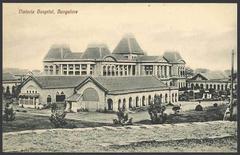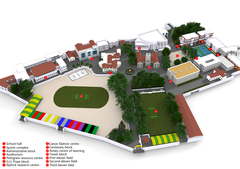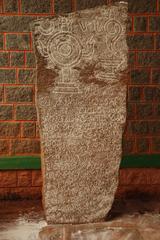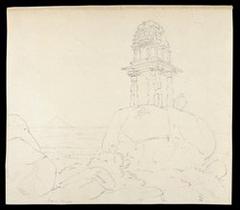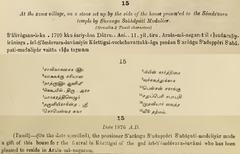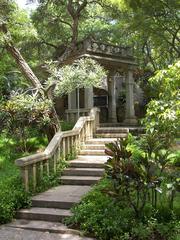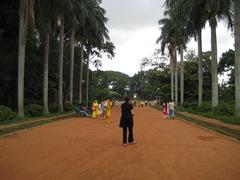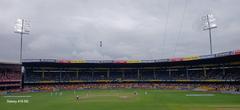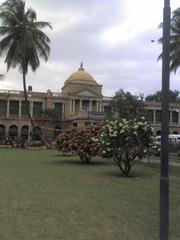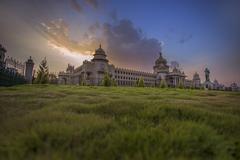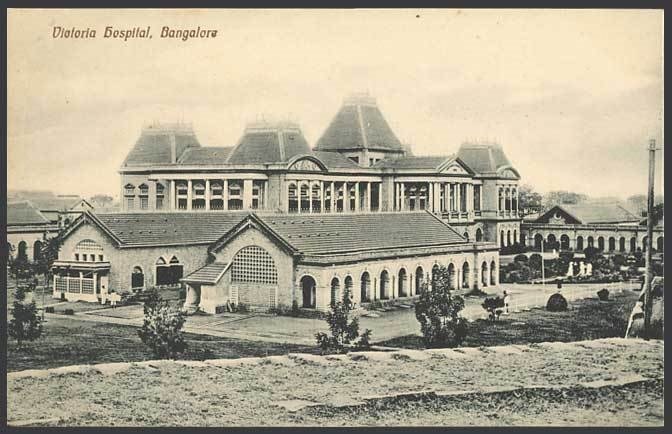
Visiting Victoria Hospital Bengaluru, India: Guide, Tickets, Hours, and Tips
Date: 15/06/2025
Introduction
Victoria Hospital Bengaluru stands as one of the city’s most iconic institutions, blending over a century of medical service with a rich architectural and cultural legacy. Established in 1900 to mark Queen Victoria’s Diamond Jubilee, the hospital is a vital public healthcare provider and a heritage landmark reflecting the city’s colonial-era past. Its impressive Gothic and British classical architecture, central location, and role in the social fabric make it a must-visit for history buffs, architecture enthusiasts, and cultural explorers.
This comprehensive guide covers everything you need to know about visiting Victoria Hospital—historical highlights, architectural features, practical visitor information, nearby attractions, folklore, and tips for making the most of your experience. For official updates and details, consult the Bangalore Medical College and Research Institute website.
(Victoria Hospital Bengaluru: Visiting Hours, History & Heritage Site Guide)
(Victoria Hospital Bangalore: Visiting Hours, Tickets, History & Tourist Guide)
(Discovering Victoria Hospital: A Historic Bengaluru Landmark)
Table of Contents
- Introduction
- Foundation & Historical Context
- Evolution and Expansion
- Architectural Significance
- Role in Bengaluru’s Heritage Landscape
- Notable Features and Facilities
- Visitor Information
- Travel Tips
- Nearby Attractions
- Preservation and Modernization Efforts
- Social Impact and Folklore
- Frequently Asked Questions (FAQs)
- Summary & Recommendations
- References
Foundation & Historical Context
Victoria Hospital was established to commemorate Queen Victoria’s Diamond Jubilee, with the foundation stone laid in 1897 by the Maharani Regent of Mysore and inaugurated in 1900 by Lord Curzon. Maharajah Shri Krishnaraja Wodeyar IV envisioned the hospital as a modern facility for the Mysore State. Beginning with 140 beds, it quickly became an essential part of the region’s healthcare infrastructure and is now one of South India’s largest government hospitals.
Evolution and Expansion
Affiliated with Bangalore Medical College and Research Institute, Victoria Hospital has grown alongside Bengaluru’s transformation. It now has over 1,000 beds and a wide array of departments, including emergency medicine, trauma, burns, plastic surgery, and more. Recent government initiatives continue to expand its capacity, with new multi-story blocks, intensive care units, and advanced diagnostic facilities. The hospital’s campus also provides subsidized accommodation for patients’ families, ensuring holistic care.
Architectural Significance
The hospital’s original buildings showcase colonial Victorian Gothic and British classical styles, with robust masonry, high ceilings, arched windows, and wide verandahs—features designed for the local climate and functional needs. The Sir Puttanna Chetty block, housing the outpatient department, is notable for maintaining its historical integrity while serving thousands of patients daily. The campus is a preserved example of Bengaluru’s colonial architectural heritage, set amidst a historic district near Bangalore Fort and Tipu Sultan’s Summer Palace.
Role in Bengaluru’s Heritage Landscape
Victoria Hospital is surrounded by some of Bengaluru’s most important heritage sites, including Bangalore Fort, Attara Kacheri (Karnataka High Court), and K.R. Market. Its continuous operation for over 120 years provides a window into the evolution of public health in India and the city’s urban development. The juxtaposition of colonial-era structures with modern hospital wings symbolizes Bengaluru’s blend of tradition and innovation.
Notable Features and Facilities
- Specialized Units: Burns, plastic surgery, trauma, neurology, cardiology, and more.
- Central Laboratory: Supported by philanthropic contributions (notably Infosys).
- Dharmashala: On-campus accommodation for patients’ families at subsidized rates.
- Pharmacy and Cafeteria: 24-hour pharmacies and basic canteen facilities.
- Outpatient Services: Free medicines and consultations for underprivileged patients.
- Accessibility: Ramps and elevators in new buildings, though some older areas may have limited access.
Visitor Information
Visiting Hours
- General Grounds: 8:00 AM – 6:00 PM daily (recommended for historical and architectural exploration).
- OPDs & Administrative Offices: 9:00 AM – 4:00 PM, Monday to Saturday.
- Patient Visiting Hours: 9:00 AM – 8:00 PM; check with hospital for specific ward timings.
Tickets & Entry
- Entry: Free; no tickets required.
- Visitor Passes: Required for inpatient areas, issued at the reception desk.
Photography
- Exterior Photography: Permitted for architectural appreciation.
- Interior Photography: Restricted; seek prior permission and respect patient privacy.
Guided Tours and Accessibility
- Guided Tours: Not offered officially, but local heritage walking groups include the hospital in their itineraries.
- Accessibility: Wheelchair ramps and elevators in newer blocks; signage in Kannada and English.
Travel Tips
- Getting There: Well-connected by BMTC buses and Namma Metro (KR Market station).
- Best Time to Visit: Weekday mornings for fewer crowds.
- Parking: Limited; public transport is recommended due to congestion.
- Safety: Stay vigilant in crowded areas and keep valuables secure.
- Etiquette: Dress modestly, avoid loud noises, and respect hospital protocols.
Nearby Attractions
- Bangalore Fort: 8-minute walk; free entry; 16th-century fortification.
- Tipu Sultan’s Summer Palace: 5–7-minute walk; Indo-Islamic architecture; entry fee applies.
- K.R. Market: 5-minute walk; bustling local market.
- Lal Bagh Botanical Garden: 2.5 km; renowned for flora and annual flower shows.
- Cubbon Park: 3 km; city’s central green space.
- National Gallery of Modern Art, Commercial Street, Vidhana Soudha, Jawaharlal Nehru Planetarium: Within 4 km radius.
(Moovit)
(Holidify)
Preservation and Modernization Efforts
Ongoing projects aim to preserve the hospital’s heritage architecture while integrating state-of-the-art medical facilities. Restoration initiatives and modern expansions are designed to harmonize with the original buildings, ensuring Victoria Hospital remains both functional and visually significant.
Social Impact and Folklore
Healthcare Pioneer
Victoria Hospital was one of the first large-scale public hospitals in South India, setting standards in both medical education and patient care. Its affiliation with BMCRI has helped train generations of doctors, and its policy of providing free medicines and affordable care has made it a pillar of the community.
(Doctors & Hospitals)
Community Integration
The hospital’s central location shaped the surrounding neighborhoods, stimulating local economies and providing employment. The dharmashala for patients’ families exemplifies its commitment to holistic care.
(Wikipedia)
Medical Achievements
Prominent doctors at Victoria Hospital have contributed to notable medical discoveries, such as the “artery of Sheshachalam.” The hospital’s role during major emergencies, including the 1981 Venus Circus fire, highlights its critical function in the city’s history.
(The Hindu)
Folklore and Legends
Victoria Hospital is the subject of local ghost stories, most notably the legend of the “Ghostly Matron” and the laughter of unseen children. While these accounts remain unverified, they are deeply embedded in the hospital’s cultural narrative and contribute to its mystique.
(Scare Sagas)
(Treebo)
Frequently Asked Questions (FAQs)
Q: What are the visiting hours for Victoria Hospital Bengaluru?
A: Grounds open 8:00 AM – 6:00 PM. OPDs/administrative offices: 9:00 AM – 4:00 PM, Mon–Sat.
Q: Is there an entry fee?
A: No, entry is free.
Q: Are guided tours available?
A: Not officially, but some heritage walks include the hospital.
Q: Is the hospital accessible for differently-abled visitors?
A: Yes, wheelchair ramps and elevators are available in newer buildings.
Q: Can I take photos?
A: Exterior photos allowed; avoid interiors without permission.
Q: What are the nearby attractions?
A: Bangalore Fort, Tipu Sultan’s Summer Palace, K.R. Market, Lal Bagh, Cubbon Park, and more.
Q: How do I reach Victoria Hospital by public transport?
A: Use the Moovit app for metro and bus directions.
(Moovit)
Summary & Recommendations
Victoria Hospital Bengaluru symbolizes the city’s fusion of history, architecture, and social service. Its central location, impressive colonial-era structures, and ongoing medical contributions make it a cultural and civic landmark. Visitors are encouraged to explore the hospital’s grounds, integrate the site into broader heritage walks, and discover the surrounding historical attractions. When visiting, respect hospital protocols, patient privacy, and the institution’s primary healthcare function.
To deepen your experience, consider local heritage tours, use digital navigation tools like the Moovit app, and reference official resources for the latest updates. Victoria Hospital’s layered narrative—spanning medical achievement, community service, and urban legend—offers an authentic portal into Bengaluru’s evolving identity.
(Victoria Hospital Bengaluru: Visiting Hours, History & Heritage Site Guide)
(Cultural, Social Impact, and Folklore)
(Visiting Victoria Hospital Bengaluru: Hours, Accessibility & Nearby Attractions)
References
- BMCRI – Official Site
- Victoria Hospital on Wikipedia
- Moovit – Public Transit Directions
- Doctors & Hospitals – Victoria Hospital
- The Hindu – Medical Feats and Resident Ghosts
- Treebo – Haunted Places in Bangalore
- Scare Sagas – Victoria Hospital
- Holidify – Bangalore Sightseeing
For in-depth travel planning, real-time updates, and curated tours, download the Audiala app and follow our social media for the latest on Bengaluru’s heritage sites.
